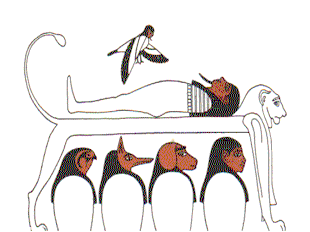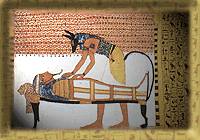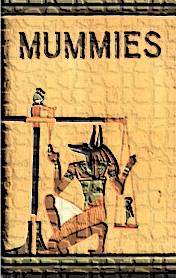


Removal of those parts most subject to putrefaction was the initial step in preparing a corpse for mummification. The embalmers placed the body on a narrow, table-like stand and proceeded to their task. The brain was removed through the nostrils by means of various metal probes and hooks. Such a method necessarily reduced the brain to a fragmentary state, and, as no remains of it are associated with mummies, we may assume that it was discarded. An incision was then made in the left flank of the body to permit removal of the viscera, with the exception of the heart, which was left in the body. |
The liver, the lungs, the stomach, and the intestines were each placed
in a separate jar, the Canopic Jars (SEE IMAGE), and consigned to the protection of a
particular divinity.
|
The final ceremony at the tomb was the "opening of the mouth." Through this ceremony the mummy was thought to regain ability to move, to talk, and to eat. In order to fulfill his destiny in the afterworld~ it was necessary that the priests perform this last rite which would restore to him the functions of a living person. |
 |
But according to Egyptian belief, interment of the mummy did not automatically insure entrance into the afterworld. The deceased had first to appear before a group of forty-two spiritual assessors and convince them that he had led a righteous life on earth. Then in a final trial before Osiris, king of the nether world, the heart of the deceased was placed on the Great Scales and balanced against a feather, symbol of righteous truth. Anubis, the jackal-headed god who presided over embalming, did the weighing, while Thoth, the ibis-headed scribe of the gods, recorded the result on a tablet. If the heart of the deceased passed this test, he was admitted into heaven. If not, his soul was doomed to roam the earth forever. |
With the Eighteenth Dynasty (1546-1319 B.c.) the mummiform type of coffin had come into general use. The ritual texts for the deceased which had originated in the ancient Pyramid Texts had developed into the elaborate Book of the Dead, which was written on a papyrus roll and enclosed in the tomb with the mummy. Sections from this book, with exquisite illustrations in color, were painted on the coffins. |
The Egyptians believed that a god incarnate assumed the form of an animal. Nearly every deity was associated in their minds with a certain bird or beast. So it is not surprising that we find near the sites of ancient cities large cemeteries devoted to the burial of animals. Usually only one kind of animal was buried in a given cemetery. Adjacent to each such cemetery was a temple devoted to the cult of the god identified with the specific kind of animal buried at that place. The animals were mummified, but not always too carefully. Chief stress was laid on the bandaging, the object having been that the package should clearly indicate the kind of animal enclosed. Often these animal mummies were placed in theriomorphic coffins. There are mummies of jackals, cats, ibises, snakes, lizards, gazelles, hawks, bulls, sheep, baboons, crocodiles--in fact, almost every conceivable kind of animal known to Egypt. At some places animal tombs such as those of the Apis bulls at Memphis are found. The tombs of the Apis bulls, which date from the Eighteenth Dynasty and later, consist of subterranean passages and vaults hewn in the rock an aggregate length of some twelve hundred feet. Many of the |
 |
Revised: November 12, 2009.
Copyright © 1997 by Anthony C. DiPaolo, M.S. / Osiris Web Design.